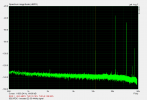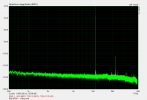For @pma's file
foo_abx 2.1 report
foobar2000 v1.6.12
2023-02-09 12:53:05
File A: 22_33_44.wav
SHA1: 5f36b0023887a9f1a42ec000d89258f4469e1bdc
File B: silence.flac
SHA1: 1c2d6c9cfa08d05537d33c607cc378ece6effd34
Output:
ASIO : KORG 2ch 1bit Audio Device
Crossfading: NO
12:53:05 : Test started.
12:53:32 : 01/01
12:53:48 : 02/02
12:54:08 : 03/03
12:54:14 : 04/04
12:54:23 : 05/05
12:54:32 : 06/06
12:54:37 : 07/07
12:54:43 : 08/08
12:54:49 : 09/09
12:54:54 : 10/10
12:55:00 : 11/11
12:55:05 : 12/12
12:55:11 : 13/13
12:55:17 : 14/14
12:55:31 : 15/15
12:55:35 : 16/16
12:55:35 : Test finished.
----------
Total: 16/16
p-value: 0 (0%)
-- signature --
54ced08743e8b217690dcd3512c817dca49d4a77
------------------------------------------------
My hearing for test tones is around 16 kHz to 17 KHz for a sine wave.
Setup is Sennheisser HD820 + Korg DS-DAC-10R, max volume.
To be clear, it's something "faint" but it's not silence. I don't hear it as 11 kHz in my brain. It feels like pressure but not a lot -- less than what'd you get when swimming.
Edit: I don't think the DS-DAC-10R is turning anything off when the signal is zero. I'm also not saying that it's worthwhile to get a system that reproduces these ultrasonics.
I'm just saying I've done my part for science and raising money for charity (ASR).
For me, I don't hear a missing fundamental. For me, the presence of inaudible ultrasonics are detectable from digital silence.
I dare not damage my hearing at this point with more testing if it's really playing with fire...
foo_abx 2.1 report
foobar2000 v1.6.12
2023-02-09 12:53:05
File A: 22_33_44.wav
SHA1: 5f36b0023887a9f1a42ec000d89258f4469e1bdc
File B: silence.flac
SHA1: 1c2d6c9cfa08d05537d33c607cc378ece6effd34
Output:
ASIO : KORG 2ch 1bit Audio Device
Crossfading: NO
12:53:05 : Test started.
12:53:32 : 01/01
12:53:48 : 02/02
12:54:08 : 03/03
12:54:14 : 04/04
12:54:23 : 05/05
12:54:32 : 06/06
12:54:37 : 07/07
12:54:43 : 08/08
12:54:49 : 09/09
12:54:54 : 10/10
12:55:00 : 11/11
12:55:05 : 12/12
12:55:11 : 13/13
12:55:17 : 14/14
12:55:31 : 15/15
12:55:35 : 16/16
12:55:35 : Test finished.
----------
Total: 16/16
p-value: 0 (0%)
-- signature --
54ced08743e8b217690dcd3512c817dca49d4a77
------------------------------------------------
My hearing for test tones is around 16 kHz to 17 KHz for a sine wave.
Setup is Sennheisser HD820 + Korg DS-DAC-10R, max volume.
To be clear, it's something "faint" but it's not silence. I don't hear it as 11 kHz in my brain. It feels like pressure but not a lot -- less than what'd you get when swimming.
Edit: I don't think the DS-DAC-10R is turning anything off when the signal is zero. I'm also not saying that it's worthwhile to get a system that reproduces these ultrasonics.
I'm just saying I've done my part for science and raising money for charity (ASR).
For me, I don't hear a missing fundamental. For me, the presence of inaudible ultrasonics are detectable from digital silence.
I dare not damage my hearing at this point with more testing if it's really playing with fire...
Attachments
Last edited:





